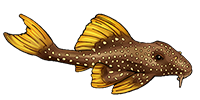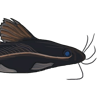A Question on microglanis
- grokefish
- Posts: 1554
- Joined: 13 Apr 2006, 19:28
- My images: 3
- My aquaria list: 1 (i:0)
- Spotted: 2
- Location 1: The Vandart Aquarium South Wales
- Interests: Life the universe and everything
A Question on microglanis
My question is:-
Why are they patterned the way they are?
This is a serious question.
Matt
Why are they patterned the way they are?
This is a serious question.
Matt
One more bucket of water and the farce is complete.
- sidguppy
- Posts: 3827
- Joined: 18 Jan 2004, 12:26
- My articles: 1
- My images: 28
- My aquaria list: 5 (i:0)
- Spotted: 9
- Location 1: Southern Netherlands near Belgium
- Location 2: Noord Brabant, Netherlands
- Interests: African catfishes and oddballs, Madagascar cichlids; stoner doom and heavy rock; old school choppers and riding them, fantasy novels, travelling and diving in the tropics and all things nature.
- Contact:
- grokefish
- Posts: 1554
- Joined: 13 Apr 2006, 19:28
- My images: 3
- My aquaria list: 1 (i:0)
- Spotted: 2
- Location 1: The Vandart Aquarium South Wales
- Interests: Life the universe and everything
Have you seen them in the wild Sid?
They certainly look like they are patterned for that reason.
However Shane, who has collected them in the wild wrote:-
Collecting location: Venezuela, Estado Miranda, Rio Merecure, Rio Tuy Drainage. Collected from the Rio Merecure near the bridge that crosses the river on the road between Caucaqua and Higuerote. Water was very clear and flowed at a moderate to strong pace. Substrate was exposed bedrock and fist-sized stones. No aquatic vegetation present. Microglanis were collected in the riffles and along the banks among the root systems and overhanging terrestrial vegetation. Water chemistry: pH 7.2, 60 ppm GH, 76-80F (warmer in the shallows). Also collected were: one species of pike cichlid, Acara sp. (Blue Acara), Hypostomus sp. fry, various tetras (mainly Astynax bimaculatus), Hoplias tetras, and Characidium darter-tetras.
Which does not suggest a leaf litter situation to me.
That is why I asked the question.
They certainly look like they are patterned for that reason.
However Shane, who has collected them in the wild wrote:-
Collecting location: Venezuela, Estado Miranda, Rio Merecure, Rio Tuy Drainage. Collected from the Rio Merecure near the bridge that crosses the river on the road between Caucaqua and Higuerote. Water was very clear and flowed at a moderate to strong pace. Substrate was exposed bedrock and fist-sized stones. No aquatic vegetation present. Microglanis were collected in the riffles and along the banks among the root systems and overhanging terrestrial vegetation. Water chemistry: pH 7.2, 60 ppm GH, 76-80F (warmer in the shallows). Also collected were: one species of pike cichlid, Acara sp. (Blue Acara), Hypostomus sp. fry, various tetras (mainly Astynax bimaculatus), Hoplias tetras, and Characidium darter-tetras.
Which does not suggest a leaf litter situation to me.
That is why I asked the question.
One more bucket of water and the farce is complete.
-
Bas Pels
- Posts: 2920
- Joined: 21 Dec 2006, 20:35
- My images: 1
- My cats species list: 28 (i:0, k:0)
- Spotted: 8
- Location 1: the Netherlands
- Location 2: Nijmegen the Netherlands
- Interests: Central American and Uruguayan fishes
I did collect my microglanis myself - in the Aroyo tropa vieja near the town Salinas (30 km from Montevideo), Canelones, Uruguay.
Most likely it is another species, but this arroyo is quite dirty, dark and unplanted. Apart from the soil, and some stones also some organic matter was around (Uruguay does not have a natural forest, it's an open, priarie like landscape).
Current was not much (hardly any rain in 2 months) but the water was clear
I saw 1 pair of Gymnogeophagus meriodonalis (no lolors though)but a lot of catfish: Hypostomus, Corydoras, Microglanis and Pimelodella
Most likely it is another species, but this arroyo is quite dirty, dark and unplanted. Apart from the soil, and some stones also some organic matter was around (Uruguay does not have a natural forest, it's an open, priarie like landscape).
Current was not much (hardly any rain in 2 months) but the water was clear
I saw 1 pair of Gymnogeophagus meriodonalis (no lolors though)but a lot of catfish: Hypostomus, Corydoras, Microglanis and Pimelodella
- grokefish
- Posts: 1554
- Joined: 13 Apr 2006, 19:28
- My images: 3
- My aquaria list: 1 (i:0)
- Spotted: 2
- Location 1: The Vandart Aquarium South Wales
- Interests: Life the universe and everything
- apistomaster
- Posts: 4735
- Joined: 10 Jun 2006, 14:26
- I've donated: $90.00!
- My articles: 1
- My cats species list: 12 (i:0, k:0)
- My Wishlist: 1
- Location 1: Clarkston, WA, USA
- Location 2: Clarkston, WA, USA
- Interests: Aquaculture and flyfishing
- grokefish
- Posts: 1554
- Joined: 13 Apr 2006, 19:28
- My images: 3
- My aquaria list: 1 (i:0)
- Spotted: 2
- Location 1: The Vandart Aquarium South Wales
- Interests: Life the universe and everything
My reason for asking this question is actually because I wish to have a go at breeding them (on purpose rather than accidentally) and would like to arrange it so as to have a typical bumblebee biotope to observe in a more natural setting.
I know that I have viable stock after my accidental breeding a while back.
Matt
I know that I have viable stock after my accidental breeding a while back.
Matt
One more bucket of water and the farce is complete.
- Shane
- Expert
- Posts: 4648
- Joined: 30 Dec 2002, 22:12
- My articles: 69
- My images: 162
- My catfish: 75
- My cats species list: 4 (i:75, k:0)
- My aquaria list: 5 (i:5)
- Spotted: 99
- Location 1: Tysons
- Location 2: Virginia
- Contact:
My theory on fishes with this general pattern (and as apisto pointed out they can moderate this pattern) is that it mimics shadow (dark areas) and light coming through the water (cream/white areas). In other words, it is a pattern useful in may environments because it is adapted to hide in the water itself instead of to match a specific substrate (like gray Chaetostoma) or structure (like the bars on Discus).
It would take days of underwater obervation to prove, but I'll bet the pattern is kept light on sunny days and dark at night and in shaded areas.
-Shane
It would take days of underwater obervation to prove, but I'll bet the pattern is kept light on sunny days and dark at night and in shaded areas.
-Shane
"My journey is at an end and the tale is told. The reader who has followed so faithfully and so far, they have the right to ask, what do I bring back? It can be summed up in three words. Concentrate upon Uganda."
Winston Churchill, My African Journey
Winston Churchill, My African Journey
- grokefish
- Posts: 1554
- Joined: 13 Apr 2006, 19:28
- My images: 3
- My aquaria list: 1 (i:0)
- Spotted: 2
- Location 1: The Vandart Aquarium South Wales
- Interests: Life the universe and everything
Thats a really interesting theory it sounds good to me and something that I will keep an eye on as the microglanis in my tank come out all the time day and night.
By the way the females are getting really fat again so there could be a possibility of something interesting happening soon.
Matt
By the way the females are getting really fat again so there could be a possibility of something interesting happening soon.
Matt
One more bucket of water and the farce is complete.
- apistomaster
- Posts: 4735
- Joined: 10 Jun 2006, 14:26
- I've donated: $90.00!
- My articles: 1
- My cats species list: 12 (i:0, k:0)
- My Wishlist: 1
- Location 1: Clarkston, WA, USA
- Location 2: Clarkston, WA, USA
- Interests: Aquaculture and flyfishing
Matt,
If they spawned before you already must have done something right.
I would give them a choice of various areas consisting of fine sands and leaf litter. Also thickets of wood and some caves.
Then I would attempt reproducing the dry season followed by a wet season along with all the live foods I could supply. I know this is not an especially original approach but it seems to work on many rarely spawned SA fish. Basically a little benign neglect followed by intense pampering.
I wish you success with your project. I always thought cracking this fish and Banjo Catfish would be interesting challenges.
If they spawned before you already must have done something right.
I would give them a choice of various areas consisting of fine sands and leaf litter. Also thickets of wood and some caves.
Then I would attempt reproducing the dry season followed by a wet season along with all the live foods I could supply. I know this is not an especially original approach but it seems to work on many rarely spawned SA fish. Basically a little benign neglect followed by intense pampering.
I wish you success with your project. I always thought cracking this fish and Banjo Catfish would be interesting challenges.
Avid Trout fly fisherman. ·´¯`·...¸><)))º>
- grokefish
- Posts: 1554
- Joined: 13 Apr 2006, 19:28
- My images: 3
- My aquaria list: 1 (i:0)
- Spotted: 2
- Location 1: The Vandart Aquarium South Wales
- Interests: Life the universe and everything
Thanks Larry,
That will be what I will be doing, I think that these fish probably spawn in many peoples tanks without them knowing it. But you think of the chances of survival for baby microglanis in a tank that contains other microglanis. Pretty slim I would have thought.
As my tank contains a number of them I will have to watch very carefully in order to step in at the right moment and get the others out.
Matt
That will be what I will be doing, I think that these fish probably spawn in many peoples tanks without them knowing it. But you think of the chances of survival for baby microglanis in a tank that contains other microglanis. Pretty slim I would have thought.
As my tank contains a number of them I will have to watch very carefully in order to step in at the right moment and get the others out.
Matt
One more bucket of water and the farce is complete.




